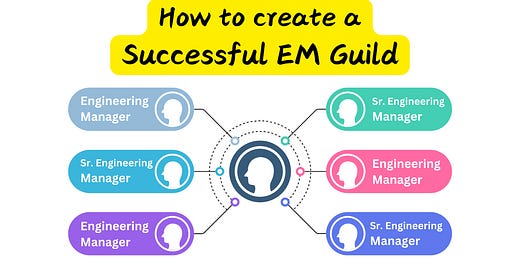What a Successful EM Guild Looks Like
How to foster a community of learning, growth, and shared leadership.
As an Engineering Manager, finding support can be difficult. Every team, company, and industry brings its own set of challenges, and what works in one environment may fail in another.
To address this, many organizations create Engineering Manager (EM) guilds. While some guilds thrive, others struggle with low engagement or quickly lose relevance.
But when done right, an EM guild provides the structure and community that managers at all levels need to grow, collaborate, and succeed.
In this article, I cover:
The purpose of an EM Guild
A step-by-step guide to setting up an EM Guild
How to get involved as an EM
What doesn’t work
1. The Purpose of an EM Guild: More Than a Meeting
A successful EM guild isn’t just another meeting. It’s a dedicated space where Engineering Managers at all levels can learn, collaborate, improve as leaders, and drive meaningful outcomes. The guild should serve as a dynamic forum that evolves with the organization and delivers tangible benefits to both individuals and the company.
What Great Guilds Deliver:
1. Knowledge Sharing: Centralized and Accessible
Tribal knowledge can’t stay locked in the heads of a few senior leaders. EM guilds create a shared repository of wisdom, making essential practices accessible to everyone.
2. Peer Support to Combat Isolation
Leadership can be lonely. Guilds offer a safe space for candid discussions about challenges like underperformance or tough conversations.
3. Leadership Development: Continuous and In-House
Rather than relying solely on external training, guilds provide a forum for ongoing leadership development.
4. Balance Between Standardization and Flexibility
As companies grow, aligning management practices becomes crucial. However, maintaining flexibility for team-specific needs is equally important.
5. Success with Clear Metrics
To prove the guild’s value, track its impact using data.
2. Setting Up an EM Guild: Step-by-Step
Creating a successful EM guild requires thoughtful planning, strong leadership, and continuous iteration. Here’s a step-by-step guide to get it right:
1. Identify a Champion
Every successful guild needs a passionate leader to drive it forward. The champion is responsible for setting the vision, organizing initial meetings, and ensuring momentum. Ideally, this person is a senior EM, Director, or VP of Engineering with experience in cross-functional leadership.
But what if no senior leader steps up? A mid-level EM with strong facilitation skills can also thrive in this role, provided they have mentorship or support from higher-level leaders.
Tip from experience:
Pair the champion with an executive sponsor to give the guild more visibility and ensure alignment with company priorities. This also helps secure resources and backing for long-term success.
2. Define Objectives
Before launching, be crystal clear about the guild’s purpose. Start by aligning the guild’s objectives with broader company goals. For example, if leadership retention is a focus, set a goal to improve EM satisfaction and development. Prioritize objectives based on their potential impact and feasibility.
Ensure each objective is measurable. For instance, “Increase new EM satisfaction scores by 20% within six months” is a clear and trackable goal.
3. Decide on Structure and Frequency
The structure and cadence of your guild depend on the size and needs of your organization. But don’t just copy-paste a format, tailor it to what works best for your team.
Here are some suggestions based on company size:
Small companies: Monthly informal discussions. Keep it casual but focused, like a roundtable over coffee.
Medium companies: Bi-weekly sessions with rotating topics, such as people management, technical leadership, or organizational design.
Large companies: Weekly or bi-weekly sessions with specific tracks for different EM experience levels (e.g., new EMs, senior EMs).
4. Create a Safe Space
Guilds thrive when members feel safe to share openly. Establish psychological safety from the outset by setting clear ground rules.
These should include:
Confidentiality: “What’s shared in the guild stays in the guild”
Respect: No idea is too small, and no challenge is too big
Supportive feedback: Focus on constructive advice, not criticism
But setting ground rules isn’t enough. Reinforce them actively. Consider using anonymous tools for gathering sensitive feedback or sharing challenges.
Tip:
Periodically revisit the ground rules and check in with members to ensure the space remains psychologically safe.
5. Start with a Pilot
Before rolling out the guild broadly, test it with a small group of EMs if possible. This allows you to experiment with the format, topics, and meeting cadence without overcommitting resources.
Set clear success criteria for the pilot. For example:
Attendance and participation rates
Engagement levels (e.g., feedback shared, questions asked)
Qualitative feedback on value and impact
After a few sessions, gather both quantitative and qualitative feedback from participants. What worked? What didn’t? Use this input to refine the guild’s structure and objectives.
Tip:
Share the pilot’s results with stakeholders to secure buy-in for a full rollout. Highlight early wins, such as improved collaboration or actionable takeaways that impacted team performance.
3. Getting Involved as an EM
Whether you’re a new EM or a seasoned leader, your participation in the guild is crucial, not just for your own growth but for the collective success of your organization. Here’s how to maximize your contribution at every stage of your journey:
For New EMs
Focus on Learning and Building Foundations
Your first priority as a new EM is to absorb as much as possible. The guild is your safe space to explore new concepts, ask questions, and build confidence in your role.
Ask Thoughtful Questions: Don’t hesitate to seek advice or clarification on challenges you’re facing.
Contribute Fresh Perspectives: Share your experiences. Your insights offer valuable context for improving onboarding or training programs for future EMs.
Set Personal Development Goals: Use the guild to define your growth areas. Share these goals with peers and seek feedback on your progress.
Build Relationships Across Teams: Treat guild sessions as networking opportunities. Forming strong cross-team connections early will help you understand the organization’s broader landscape.
For Mid-Level EMs
Shift from Learning to Leading
As a mid-level EM, your role in the guild is to guide others while continuing to develop your leadership skills. This is a pivotal stage where you balance personal growth with contributing to the growth of others.
Mentor New EMs: Share your experiences and help newer EMs navigate challenging situations.
Lead Targeted Sessions: Volunteer to lead discussions or workshops on topics where you have expertise.
Drive New Initiatives: Propose and lead activities that enrich the guild, such as book clubs, guest speaker events, or case study reviews. These initiatives add variety and keep the guild dynamic.
Collaborate Across Levels: Partner with senior EMs to co-facilitate sessions. This allows you to broaden your perspective while contributing your own insights.
For Senior EMs
Shape Strategy and Develop Future Leaders
As a senior EM, your role extends beyond individual contribution. You’re now responsible for steering the guild’s direction and ensuring it aligns with organizational goals.
Shape the Guild’s Strategy: Collaborate with other senior leaders and the guild champion to align guild activities with key company objectives, such as improving retention or scaling leadership capacity.
Mentor Mid-Level EMs: Help mid-level EMs step into more senior roles by offering strategic guidance, sharing feedback, and modelling leadership behaviours.
Lead Advanced Discussions: Dive into complex topics like scaling teams, influencing at the executive level, or leading during organizational change. Your experience can help the guild tackle broader challenges.
Foster Cross-Level Collaboration: Regularly seek feedback from new and mid-level EMs to ensure the guild addresses challenges across the spectrum of experience levels.
4. What Doesn’t Work
Sadly not all EM guilds succeed. Without careful planning and execution, they can quickly lose momentum and value. Here are the most common mistakes and how to avoid them:
1. Lack of Clear Ownership
Without a dedicated champion or steering committee, guilds often lose focus and direction. Ownership isn’t just about organizing sessions; it’s about driving long-term engagement and aligning guild activities with organizational goals.
Ensure Strong Leadership: Appoint a champion who has both the bandwidth and influence to lead effectively. This person should have a clear mandate from senior leadership to prioritize guild activities.
Establish a Steering Committee: A group of 3-5 diverse EMs can share the workload and bring varied perspectives. Rotate committee members periodically to keep ideas fresh and prevent burnout.
Plan for Continuity: Have a clear succession plan in case the champion or committee members step down. This ensures the guild remains sustainable over time.
2. Irrelevant Topics
Guilds often lose momentum when sessions don’t resonate with attendees. Misaligned topics can lead to disengagement and wasted time.
Tailor Topics to EM Levels: Different levels of EMs face unique challenges.
Leverage Data and Feedback: Use surveys, retrospective discussions, and performance reviews to identify recurring challenges. Align topics with these real-world needs.
Balance Tactical and Strategic Content: Alternate between day-to-day management topics and higher-level discussions.
3. Lack of Consistency
Infrequent or irregular meetings can cause the guild to lose momentum. Without a regular cadence, it’s hard to build trust, continuity, and sustained participation.
Stick to a Predictable Schedule: Whether it’s bi-weekly or monthly, set a recurring time for guild sessions and communicate it well in advance.
Rotate Facilitation: Assign different EMs to lead each session, spreading the workload and ensuring varied perspectives.
4. Not Acting on Feedback
A guild that doesn’t adapt based on member feedback will become irrelevant. When members feel their input isn’t valued, they’ll disengage.
Create a Feedback Loop: Regularly collect input via surveys or retrospectives. Focus on actionable feedback that can drive meaningful improvements.
Close the Loop: Communicate back to the guild what changes are being made based on their feedback. This reinforces that their voices are heard and valued.
Prioritize Feedback Wisely: Not all feedback will be actionable immediately. Be transparent about why certain suggestions are or aren’t being implemented to maintain trust.
Useful links
📂 Get my 50 Engineering Manager Notion Templates to streamline hiring, onboarding, team management, and more!
🎉 CodeCrafters helps you become a better Software Engineer using my favourite method! Build your own Redis, Git, Kafka and more from scratch. Use my partner link if you want to get 40% off.
🚀 Check out my Leadership Accelerator program. Let’s set up a free intro call and chat about how I can help you in your leadership journey.
👋 Let’s connect on LinkedIn to exchange ideas, share insights, and grow together!
If you wish to make a request on a particular topic you would like to read, you can send me an email at stephane@em-tools.io.






Thanks for sharing!
Would love to hear what are some common topics in the guild events :)
Great article!
The mutual support is definitely needed. I've seen some of the managers that I've worked with always giving more and more to their teams without not much of a support system for themselves.